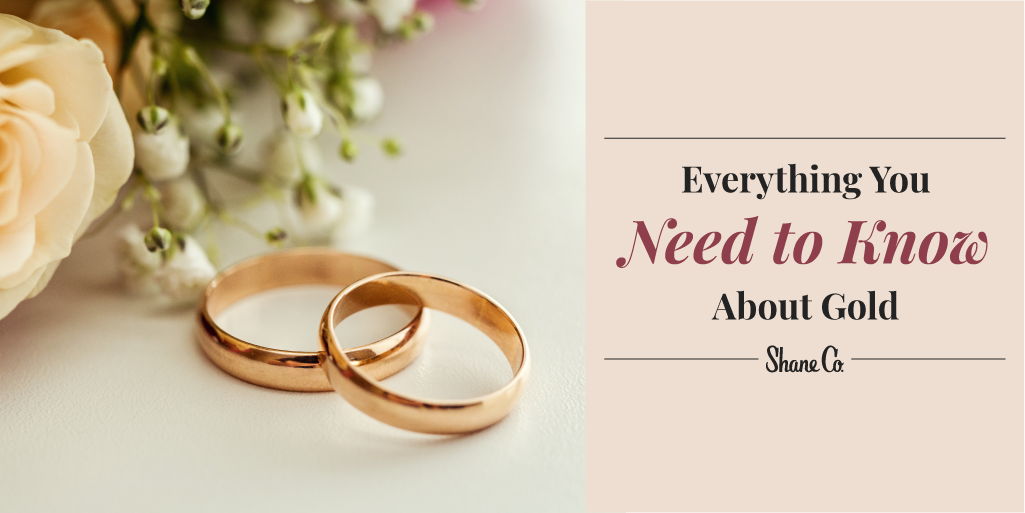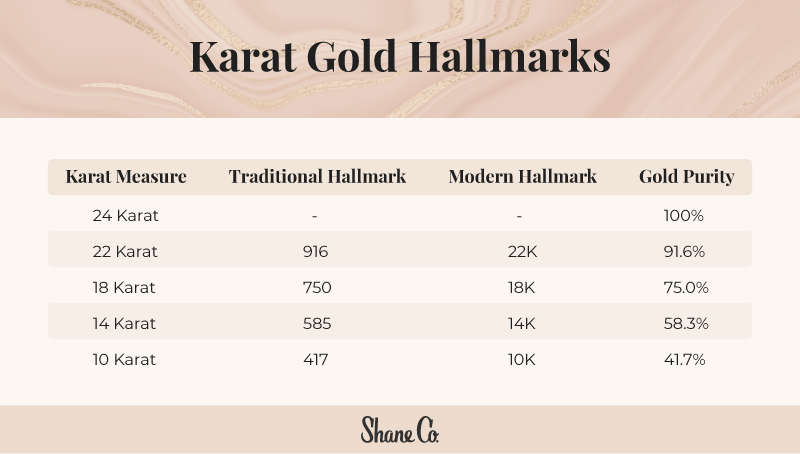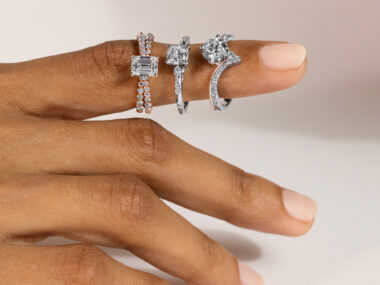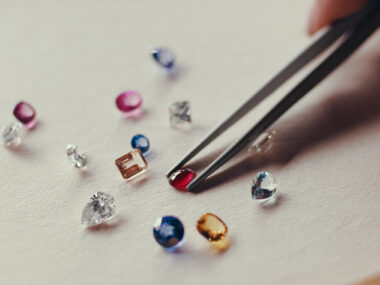
Gold is a dense, natural element that has captured the attention of humans for thousands of years. Since the time of the ancient Egyptians, who spared no expense in their lavish adoration of gold, this magnificent yellow metal has captivated humankind.
Today, gold is still a dominant choice for jewelry aficionados with a taste for luxury and class. Yet not all gold is equal, and figuring out which gold to get can be a nuanced and time-consuming process. From different levels of purity to a variety of ways to apply it to non-precious metals, not all that glitters is gold.
In this guide, we’ll cover everything you need to know about gold. We’ll discuss gold application processes, purities, and even prices so you can have a better understanding of what your gold is worth. Let’s start with the major types of gold.
What Are the Different Types of Gold?
Solid gold is a metal that is made either entirely out of pure gold or includes a large percentage of gold in addition to base metals. Gold doesn’t tarnish, rust, or corrode, making it an excellent choice for those who prefer to sweat, swim, and shower in their jewelry. It comes in a variety of colors, from its natural flaxen hue to white and even rosy pink.
Here are the types of solid gold jewelry found at most jewelers:
Pure Gold
Pure gold is exactly what it sounds like — 100 percent gold unearthed from rocks, veins, and alluvial deposits as nuggets or grain. It is the purest, most natural form of gold with no additional metals added. Because it is the most authentic, it is also the most expensive gold on the market.
But despite its alluring value, it isn’t used for jewelry because of how incredibly soft it is. It is the most malleable metal, making it very susceptible to scuffing, scratching, bending, and breaking. Therefore, alloys are used when making gold jewelry in order to blend value and rarity with the hardness that allows for everyday use without fear of damage.
Gold Alloys
Smelters can change the hardness, color, and value of natural gold by mixing it with other metals, creating a combination metal called an alloy. This allows for gold with different physical or aesthetic properties — primarily, alloys are used to increase the durability of gold and to make more affordable jewelry available to the masses.
Gold alloys are considered to be “solid” gold, despite not including 100 percent pure gold. Copper, zinc, nickel, and silver are all common materials used in gold alloys. There are three major alloys you can find at most jewelry stores, including yellow, white, and rose gold.
Yellow Gold
Yellow gold is a traditional style and exudes a timeless essence. Yellow gold jewelry, while looking similar to pure gold, is actually alloyed with copper and silver to varying extents depending on the hardness level desired for the piece. It loses some of its yellow appearance as more base metals are added, but gains additional durability in the process.
White Gold
White gold is made from mixing gold with metals like nickel, palladium, zinc, and copper, and is one of the most popular solid gold alloys due to its contemporary appeal. Because of the addition of non-precious or semi-precious metals, white gold is not only beautiful but also an affordable choice.
Note: One of the myths surrounding white gold is that it yellows over time. But in fact, that straw yellow hue is actually the true color of the gold! No white gold is purely white, so it is often plated with rhodium, a metal from the platinum family. Over time, the rhodium wears away from daily use and reveals the straw-tinted white gold underneath. To protect your gold and bring it back to its original color, bring it to a jeweler for a simple re-plating process.
Rose Gold
Rose gold is the beautiful, blush-pink alloy of gold that has risen in popularity during recent years. Typically, rose gold is 14 karats, but more or less copper can be mixed with the gold to achieve unique shades of pink. This keeps rose gold ever-intriguing and flattering for a wide variety of skin tones.
At Shane Co., we use a proprietary alloy for rose gold that no one else has. Dubbed our “signature shade,” it is consistent across all of our rose gold jewelry and can’t be found anywhere else. We’ve found this shade to match incredibly well with the widest range of skin tones and combines beautifully with a rainbow of colorful gems.
What Is the Difference Between Gold Karats?
Yellow, white, and rose gold alloys can all be adjusted to control for their purity, which affects their durability and price. The purity of gold alloys is measured in karats, with a K, not to be confused with carats, which is a measurement for diamond weight. Essentially, the more karats, the more pure gold an alloy contains. Of course, pure gold itself carries the highest purity rating that can be bestowed upon gold — 24 karats.
Because 100 percent gold is 24 karat, we can uncover the gold percentages of lesser karat golds with simple math. The percent of gold will be equal to the karat rating of your gold divided by 24. For instance, 22 karat gold is 91.7% pure gold because 22 / 24 = 0.917
- 22K is 91.7% gold
- 18K is 75.0% gold
- 14K is 58.3% gold
- 10K is 41.7% gold
How do you know the purity of gold in your collection or that you intend to buy? Each piece of jewelry is stamped with a hallmark or a small script that dictates the karat measurement of the metal. Hallmarking dates back to 1238, when Henry III made the first attempt at regulating the standard of gold and silver wares in England.
Today, you’ll either see a modern or a traditional hallmark on jewelry. Modern hallmarks are straightforward, including a number and the letter “K” to distinguish the number of karats. Traditional hallmarks include three digits that describe the percentage of pure gold to the tenth place. For example, the hallmark “916” represents an alloy containing 91.6% pure gold, which is 22 karat.

If you have an heirloom piece that is missing a hallmark or it flattened from wear, there are chemical testing kits to help determine the purity of your gold at home. However, if you don’t trust these DIY kits, you can always bring your piece to a reputable jeweler like Shane Co. to have it tested professionally.
High vs. Low Levels of Gold Purity
Choosing the right level of gold purity is a delicate dance between desirability, usability, and color. Purer forms of gold are richer in color and value, yet suffer low durability. They are better suited for treasured pieces that you might use rarely for very special occasions. Less pure gold, then, sacrifices value and color for increased durability. These alloys are used for everyday pieces like engagement rings or wedding rings that users tend to wear every day and even work or shower in.
It is possible for gold to be so impure that it loses too much value. Anything below 50% gold is often considered to be discount gold or costume jewelry and most jewelers will not carry it. At Shane Co., you will only find gold jewelry of 14k and above, as 10k gold and below does not meet our high standards of quality.
Average Price Ranges for Solid Gold Jewelry
So, how much should you pay for gold, and how much are your own pieces worth? There are several factors that go into the price of new gold jewelry, including the purity of the gold itself, labor to fashion the piece, overhead, and even distribution costs.
If you’re looking to get some extra cash out of old, unwanted pieces you already own, the value will be determined by the amount of pure gold in the piece (its karat measurement) and the world market price for gold as a commodity. Here is more information on determining the price of gold.
As a commodity, the price of pure gold fluctuates. See the chart below for the average price for gold in January of each year from 2017 through 2021.

How Is Gold Applied to Other Metals?
If you’re looking for a cheaper option and don’t mind forgoing some of the authenticity of solid gold jewelry, there are methods of adhering thin layers of gold over cheaper base metals. This allows a piece to look just like gold but carries a drastically lower sticker price.
Gold Plated
Gold-plated jewelry is the most affordable option compared to pieces made with karat gold. A very thin layer of gold adheres to a low-quality base metal through a process called electroplating. Typically, copper or brass are used as base metals and make up the bulk of the piece. However, the base metal is completely covered by the gold veneer, giving off a convincing appearance of solid gold jewelry. Because the gold plating is so thin, these pieces are keen to tarnish and must be taken care of especially well.
Gold Vermeil
Gold vermeil, pronounced “ver-may,” is the Cadillac of gold plating. The process is extremely similar to gold plating, except for the base metal used and the thickness of the plating. Vermeil uses high-quality silver as a base for the gold electroplating process. In addition, the layer of gold is thicker and more durable.
True vermeil plating is at least 100 millionths of an inch thick and consists of at least 10k gold. The gold alloy used is nickel-free and the base metal is silver, meaning gold vermeil is hypo-allergenic. Good news for those who break out in skin irritations when wearing certain jewelry!
Gold Fill
Gold fill has a low-quality base metal, similar to gold-plated pieces. However, it features the thickest layer of gold out of the three methods. The gold is also bonded to its base using high heat instead of electroplating. To qualify as authentic gold fill, the gold must make up at least five percent of the weight of the entire piece. Gold fill pieces typically use 14k gold, making them the most durable and least susceptible to tarnish, compared to gold plating or gold vermeil.
Final Thoughts
You should now be equipped to knowledgeably shop for your next gold piece. Whether it be a gift for someone you love or a splurge for yourself, you can rest assured you’ll choose the right gold type, purity, or plating method. Remember, Shane Co. offers a wide variety of the finest gold jewelry to make your shopping as easy as possible. Still have questions? No problem! We’re always available to chat.
Looking for more information on gold terminology? Make sure to check out our gold glossary below.
Gold Glossary
Alloy: The resulting material when metal is mixed with another metal to achieve desired properties.
Corrosion: The chemical degradation of material through exposure to oxygen. Gold is impervious to tarnish and corrosion, but base metals are not.
Element: A naturally occurring substance that can’t be broken down any further. Pure gold is an element, abbreviated by Au on the periodic table of elements.
Karat: A measure of the amount of pure gold that is in an alloy. One karat is 1/24 of the mass of the metal. Therefore, pure gold has 24 karats.
Hardness: A measurement of how hard a material is relative to a diamond, the hardest material on Earth. Pure gold is incredibly soft, scoring just 2.5 on the Mohs scale. 14k gold, by comparison, is between 3.5 and 4 on the Mohs scale.
Malleability: Similar to hardness, this is a description of how easy it is to bend or hammer metal into shapes. Gold is very malleable and can be easily hammered into thin sheets.
Metal: A class of elements with specific physical properties, such as light reflection, electrical conduction, and malleability.
Ore: A piece of rock from which minerals and metals may be extracted.
Tarnish: A form of corrosion, tarnish is a physical effect that dulls the luster of a mineral or metal when it is exposed to air and dirt.
Vein: A deposit of minerals or metals in a fracture in the earth.


